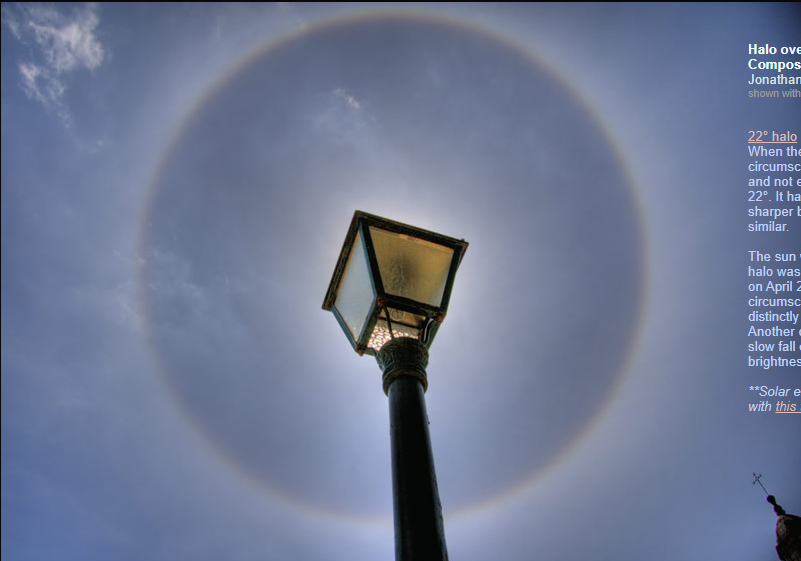22 degree halo?
The 22 Degree Halo: A Fascinating Atmospheric Optics Phenomenon
Have you ever looked up at the sky and noticed a circular halo surrounding the sun? This mesmerizing optical phenomenon is known as the 22 degree halo. While it may seem simple at first glance, there are actually some intriguing details to explore. In this article, we will delve into the characteristics and distinguishing features of the 22 degree halo, shedding light on its captivating nature.
The Distinction: 22° Halo vs. Circumscribed Halo
When the sun is positioned high in the sky, it can be quite challenging to differentiate between the 22 degree halo and another similar phenomenon called the circumscribed halo. At this angle, the circumscribed halo appears almost circular, making it indistinguishable from the 22 degree halo to the untrained eye. However, there are a few key characteristics that set them apart.
One noticeable difference lies in the intensity of colors and sharpness. The circumscribed halo exhibits brighter and more vibrant hues compared to the 22 degree halo. Additionally, the circumscribed halo tends to be sharper in appearance. These distinctions, though subtle, provide valuable clues for identifying which phenomenon is present.
Solar Altitude and Halo Formation
The altitude of the sun plays a significant role in determining whether we observe a 22 degree halo or a circumscribed halo. For instance, if the sun is positioned at an altitude of 61 degrees, as was the case on April 27th at 14:20 local time, a distinct oval shape would be visible if it were a circumscribed halo. However, in this particular instance, what was observed was indeed a 22 degree halo.
One telltale sign that confirms the presence of a 22 degree halo is the gradual decrease in brightness outside the 22 degree circle. Unlike other halos that exhibit a more abrupt decrease in brightness, the 22 degree halo maintains a gentle fade, further solidifying its identity.
Calculating Solar Elevation
If you're curious about the precise elevation of the sun at any given time, there are tools available to help you calculate it. By utilizing these tools, you can gain a deeper understanding of atmospheric optics phenomena and potentially predict the likelihood of observing a 22 degree halo or other captivating optical displays.
Conclusion
The 22 degree halo is a fascinating atmospheric optics phenomenon that enchants sky gazers around the world. Its resemblance to the circumscribed halo and its distinct characteristics make it an intriguing subject of study. By understanding the subtle differences between these halos and exploring the factors that contribute to their formation, we can appreciate the intricate beauty of our atmosphere.
So, next time you find yourself basking in the warmth of the sun, take a moment to look up and see if you can spot the elusive 22 degree halo. It serves as a reminder of the wonders that surround us and the hidden complexities within our natural world.

Halo over Santiago de Compostela, Spain imaged by Jonathan Shock. ©Jonathan Shock, shown with permission.
22° halo or circumscribed halo? When the sun is high the circumscribed halo is almost circular and not easy to distinguish from the 22°. It has brighter colours and is sharper but otherwise is very similar.
The sun was 61° high.. when this halo was seen at 14:20 local time on April 27th. At that altitude a circumscribed bow would be distinctly oval. This is a 22° halo. Another clue to its identity is the slow fall off in the bright white halo brightness outside the 22° circle.
..Solar elevation can be calculated with this tool.
Note: this article has been automatically converted from the old site and may not appear as intended. You can find the original article here.
Reference Atmospheric Optics
If you use any of the definitions, information, or data presented on Atmospheric Optics, please copy the link or reference below to properly credit us as the reference source. Thank you!
-
<a href="https://atoptics.co.uk/blog/22-degree-halo/">22 degree halo?</a>
-
"22 degree halo?". Atmospheric Optics. Accessed on April 24, 2024. https://atoptics.co.uk/blog/22-degree-halo/.
-
"22 degree halo?". Atmospheric Optics, https://atoptics.co.uk/blog/22-degree-halo/. Accessed 24 April, 2024
-
22 degree halo?. Atmospheric Optics. Retrieved from https://atoptics.co.uk/blog/22-degree-halo/.